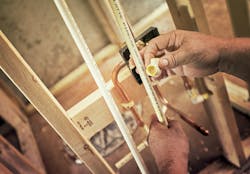CPVC pipes and fittings have been used in US homes for more than 60 years due to their durability, immunity to chlorinated drinking water, and ease of installation. Service plumbers may encounter CPVC pipes that were installed anywhere from five months to five decades ago. Keeping the following points in mind when servicing this popular material can help protect the longevity and performance of CPVC pipes and fittings, regardless of their vintage.
The Right Tools for the Job
One of the many advantages of CPVC is that it does not require special tools or equipment for installation. But different tools should be used when cutting previously installed CPVC pipes than those used for pipes in new installations.
As it ages, CPVC naturally becomes more rigid and may even show signs of discoloration. These changes do not reduce the expected service life of the pipe. In fact, the pressure-bearing capability of CPVC pipes actually increases with age and older CPVC pipe can typically remain in service when properly handled.
As the aged pipe becomes more rigid, it must be cut and handled differently than new pipes. Always use a C-style tubing cutter, a fine-tooth saw or a wheel cutter when servicing CPVC. Ratchet cutters or shears are not recommended for cutting previously installed CPVC pipes.
Service plumbers also typically use a different, faster curing solvent cement than plumbers working in new construction. The solvent weld process used to chemically fuse CPVC pipes and fittings creates a single-piece joint that is stronger at the fitting than the pipe alone once the solvent cement cures.
Cure times may be a concern for service plumbers using the standard one-step solvent cement used in new construction. Because service plumbers often need to make repairs quickly and get to the next job, a specially formulated solvent cement, Oatey Orange Lava, was developed. It enables one-step cure times as fast as 15 minutes for cold water lines.
Always verify code requirements and follow the solvent cement manufacturer’s recommendations for cure times and installation procedures.
Ensuring Future Reliability
Because CPVC is immune to chlorine-based disinfectants in drinking water, CPVC pipe failures can typically be traced to installation error, whether that is improper installation or exposure to incompatible chemicals.
Most service plumbers have probably encountered improper installations resulting from homeowners seeking to save a few bucks by taking a DIY approach to plumbing. These errors can include using the wrong fitting, excessively stressing the system, using the wrong cement, or not using any cement at all. When servicing CPVC, solvent weld each fitting before moving on to the next to lower the risk of dry fits and reference manufacturer-recommended guidelines to accounting for expansion and contraction.
When properly installed CPVC has failed, one likely culprit is contact with incompatible chemicals. Depending on the type and amount of incompatible chemical that a pipe is exposed to, the failure may happen quickly or could take years to develop. Service plumbers may commonly encounter chemical incompatibility under sinks where the pipe can be exposed to surfactant chemicals found in some household cleaners. In these situations, the CPVC stub-out should be replaced with a CPVC-to-copper stub-out.
If you ever have questions about whether a chemical or material is compatible or incompatible with FlowGuard Gold CPVC, consult the FBC™ System Compatible Program for more information.
Minimizing the Risk of Freezing
Experienced service plumbers know that all piping materials can experience failure due to freezing.
But there is a common misconception about how freezing affects plumbing materials. It isn’t the pressure of the ice pushing on the pipe that causes failure. It is the internal water pressure that builds when an expanding ice plug pressurizes liquid water trapped in the pipe. That means a pipe’s pressure-bearing capability, more than its flexibility, is the key factor determining its susceptibility to failure from freezing.
CPVC has a minimum quick burst pressure of 1250 psi, which is more than double that of PEX. But pressures created in a frozen pipe can quickly exceed those limits as well as the even higher 3000+psi burst pressure of copper. So CPVC should be protected from exposure to outside conditions like other plumbing materials.
Whenever possible, avoid installing pipes in uninsulated areas such as attics, crawl spaces, and overhangs. When pipe must be installed in these exposed areas, appropriate and compatible insulation between the pipe and exterior wall, floor or ceiling can help slow the rate of freezing. For added protection, tubing insulation and heat trace tapes can be used, but be sure to confirm the compatibility of those materials using the FBC System Compatibility Program.
Holes or gaps in exterior walls for cable or electrical penetrations can allow a direct path for cold air to reach pipes, creating a “wind chill” effect that accelerates freezing. Sealing exterior penetrations and gaps helps prevent cold air from flowing around the pipes.
Durability and Serviceability
CPVC is designed to be easy for plumbers to work with in both new construction and service. It does not require specialized tools or equipment that can be difficult to work with in tight spaces; new CPVC pipes are typically flexible enough to snake through walls but not so flexible that they will coil when being pushed; and plumbers have easy access to a trusted source for finding out what is compatible and incompatible with the leading brand of CPVC. Just remember to use the right tools, enjoy the benefits of fast-curing cement, and take advantage of the resources available from CPVC manufacturers and you can service CPVC with confidence.
Jonathan Simon is the North American residential plumbing manager for Lubrizol Advanced Materials Inc., the parent company for FlowGuard Gold Pipe and Fittings.
About the Author
Jonathan Simon
Jonathan Simon is the North American residential plumbing manager for Lubrizol Advanced Materials Inc., the parent company for FlowGuard Gold Pipe and Fittings.

